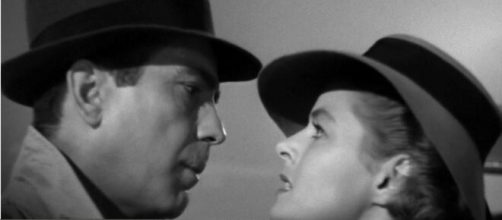It’s been 80 years since the WWII romance “Casablanca” premiered at New York’s Hollywood Theatre, and The Guardian writer Scott Tobias asked a question that goes begging: “Where can you find any weaknesses in this production.” How about the last scene between Rick (Humphrey Bogart) and Ilse (Ingrid Bergman)?
Weeping Woman
Remember the scene – the pea-soupy atmosphere on the airport tarmac? The air was so foggy that you wondered if flying was safe; although the mist went so well with Ingrid Bergman’s tears.
The film’s fault lay in the lovers’ dialogue because it made Humphrey Bogart sound thoughtful and heroic, and Bergman a mindless mush.
Rick, you may remember, is a world-weary expat American saloon keeper in Morocco who cynically proclaims early in the movie: “I stick my neck out for nobody.” In contrast, Ilse, once Rick’s lover, is now the wife of Victor Lazlo, a resistance leader in the war against the Nazis and in constant danger of capture.
Rick is the real crybaby
Rick is in a position to help the couple with letters of transit, but he’s bitter over losing Ilse and doesn’t agree to help until she says she still loves him.
Emboldened by that reassurance, Rick opts to do the right thing. In their final scene, he talks to Ilse as if she were a clinging child: “What I’ve got to do, you can’t be any part of... Someday you’ll understand that.”
“Someday you’ll understand that”?
Ilse understood that long before Rick did. While Rick spent the war licking his wounds, she was supporting a freedom fighter.
Yet, the dialogue shows Rick acting like the grownup, and Ilse the confused child. Even though feminism was not a thing in 1942, it makes no sense for a cynic to lecture an idealist.
"Men act and women appear," John Bergman wrote in his 1970 art book "Ways of Seeing." He contended that in the history of art, women are not participants.
They are objects.
Henri Matisse’s “The Dance” illustrates his point. Five women in dance formation are made to look anonymous. They all look alike. They’re also all nude as if to underscore their anonymity. Objects, all. Ilse multiplied by five.
Edgar Degas also makes Bergman’s point. The artist’s favorite subject was women in their baths – faceless, stripped of personality.
They are mere elements of color and shape; Bathsheba without a story.
Objectifying women is an old story. Even when a male painter shows a female soldiering in war, she’s made to look homicidal.
I’m thinking of Henri Rousseau’s painting “War,” which portrays a female as a deadly instrument of war riding a black horse with a raised sword riding across a landscape of mutilated men.
So, you either get a warring woman or the weeping one. The final scene of Rick and Ilse is reminiscent of the painting “Jupiter and Thetis” by Jean-Auguste Ingres.
Ingres describes the Old Romans’ most powerful god, seated on a golden throne, smirking at us while the adoring female (Thetis) coils herself around his knees – Ilse and Rick personified.


